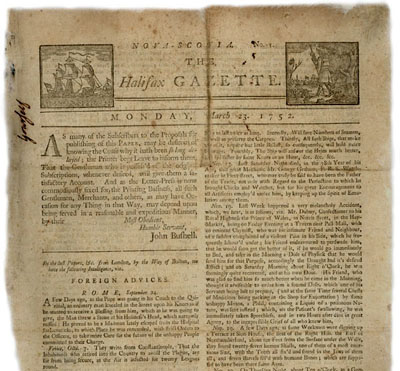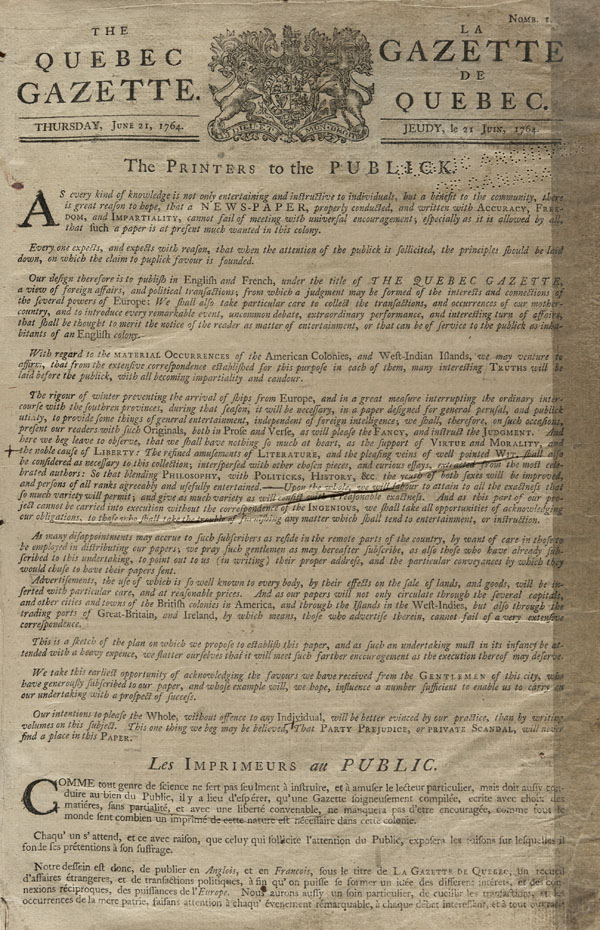This entry is part of a series on the history of the newspaper industry in Canada. See also Newspapers in Canada: 1800s–1900s.

First Newspapers in Canada: 1750s–1800s
Most colonial newspapers in North America were directly connected to commercial printing operations that depended on government subsidies to operate. Known as “King’s Printers,” they were independent businesses that received most of their income from printing materials for colonial officials, such as proclamations, laws and regulations. The first printers set up shop in Halifax, Québec City and Montréal in the 1750s and published weekly newspapers, known as gazettes, that disseminated official notices on behalf of colonial administrators. Their reliance on revenues from sources other than readers — from governments, political parties and advertisers — was characteristic of Canadian newspapers until the 1850s, when colonial populations and commerce expanded and reader and advertising revenues became more profitable.
Following the outbreak of the American Revolution in 1775, a large number of skilled Loyalist printers arrived from New England. By the mid-1780s, there were weekly newspapers in Saint John, New Brunswick (Royal Gazette and the New Brunswick Advertiser, 1785) and Charlottetown, Prince Edward Island (Royal American Gazette, and Weekly Intelligencer of the Island of Saint John, 1787).
(See also Print Industry.)
Halifax Gazette
The Halifax Gazette was the first newspaper published in what is now Canada. Its first edition, a two-page paper, was printed on 23 March 1752. It was started by John Bushell, a printer who had arrived in Halifax months earlier to run the city’s first printing press. The first editions of the Halifax Gazette published excerpts from British and European publications, as well as news from the British colonies in America and the Caribbean. Halifax had been settled just three years before the Halifax Gazette was founded and had a small population (about 4,000 people). As a result, local coverage was small but grew over time. About one-quarter of the Halifax Gazette was dedicated to Nova Scotia news, including proclamations, notices of ship arrivals and reports of stolen goods and even runaway slaves.

After several name changes, the paper became the Royal Gazette, which remains the official publication of the provincial government of Nova Scotia.
Newspapers in Québec
There were no newspapers in New France (1608–1763), largely because French officials opposed the establishment of printing presses in the colony. But after the British Conquest and the end of the Seven Years’ War in 1763, printers began to arrive in the province of Québec from the American colonies.

Quebec Gazette/Gazette de Québec
William Brown and Thomas Gilmore, published the first edition of the bilingual Quebec Gazette (Gazette de Québec) in Québec City. The four-page paper included many government announcements and two pages of advertisements, both of which financed the paper. The Quebec Gazette was the first newspaper in the province of Québec and began with the ideal of informing the public with impartiality. Its editors were known to reprint political commentary from both the British and republican (American) perspectives. However, mention of the revolutionary events in the American colonies was censored by Governor Guy Carleton after 1768, and publication of the paper was suspended during the American invasion of Québec in 1775–76.
The Quebec Chronicle-Telegraph, an English-language weekly published in Québec City, is a descendant of the Quebec Gazette, which merged with the Morning Chronicle in 1874 and the Daily Telegraph in 1925.
Montreal Gazette
In May 1776, Fleury Mesplet, a printer from Philadelphia, arrived in American-occupied Montréal to set up a French-language printing press. When the Americans withdrew from Montréal weeks after his arrival there, Mesplet was jailed because of his attempts to persuade Québec to join the American Revolution. He was released shortly after and, on 3 June 1778, published the first fully French-language newspaper in Canada, La Gazette du commerce et littéraire, pour la ville et district de Montréal. In 1779, the Gazette was suspended when Mesplet and the paper’s editor, Valentin Jautard, were arrested by colonial authorities and jailed for their radical views.
Mesplet was released from jail in 1782 because Montréal lacked a capable printer. On 25 August 1785, he published the first edition of the bilingual Montreal Gazette/La Gazette de Montréal. It wasn’t an official government gazette and was instead critical of the Catholic clergy and the seigneurial system. The paper also published stories about education, literature and politics. By 1788, for example, the Montreal Gazette demanded that a legislative assembly be established in Québec. The Montreal Gazette included advertisements, which brought a new stream of revenue to the paper. According to historian Claude Galarneau, the ads can be read as historical documents that “reveal the rapid development of Montréal’s economic, social and cultural life.” It’s one of the oldest surviving newspapers in Canada.
Upper Canada Gazette
In 1793, Louis Roy — who worked for both William Brown and Fleury Mesplet — was hired as Upper Canada’s official printer by lieutenant-governor John Graves Simcoe. While operating the press from Newark (now Niagara-on-the-Lake), Roy established the first newspaper in what is now Ontario: the Upper Canada Gazette, or American Oracle. Its first edition, published on 18 April 1793, was an official government gazette. The Upper Canada Gazette published government announcements, as well as non-government news, including advertisements, foreign news and some local news, editorials and letters to the editor. Unlike more modern newspapers, its stories did not carry author bylines or headlines. Instead, the titles of articles read “From a New York paper” or “We have extracted the following from a London paper.”
Brothers Gideon and Silvester Tiffany took over the press and publication after 1794. They published news from the United States, which was of interest to their readers, who were Loyalists who had moved to Upper Canada. As a result, colonial administrators reprimanded the Tiffanys for their “republican support.” The Upper Canada Gazette moved to York (now Toronto) in 1798 and became an official government gazette.
On 20 July 1799, the Tiffanys published the Canada Constellation, the first independent newspaper in Upper Canada. It folded shortly after, in 1800.

 Share on Facebook
Share on Facebook Share on X
Share on X Share by Email
Share by Email Share on Google Classroom
Share on Google Classroom


